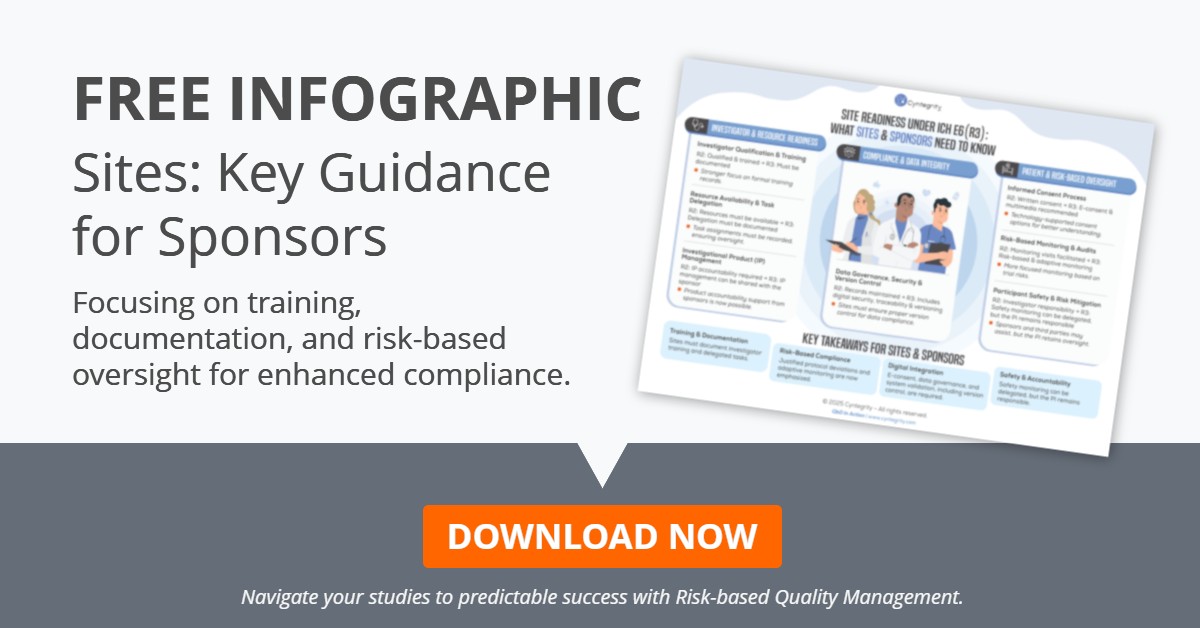Elevating Clinical Research Training
Introduction
As training, clinical operations, and compliance managers within the clinical research sector, staying abreast of the industry’s latest developments is critical. One such development is the International Council for Harmonisation (ICH)’s release of the draft guidelines of E6(R3) on May 19, 2023. This article will outline the key elements of the E6(R3) guidelines, pinpoint areas requiring further guidance, and draw comparisons with the E8(R1) guidelines, highlighting potential training gaps.
A Deep Dive into the ICH E6(R3) Guidelines
The E6(R3) guidance represents a transformative shift in the ICH’s approach to clinical research, underscoring the principles of Quality by Design (QbD), Risk-Based Quality Management (RBQM), and critical-to-quality (CTQ) factors approach. As managers in charge of training, it is advisable to incorporate these concepts into the educational curriculum designed for your study teams:
- Quality by Design (QbD): The guidelines stress incorporating quality during the design phase of clinical trials, prioritizing patient safety and data integrity (Section 3).
- Risk-Based Quality Management (RBQM): The guidance calls for risk identification, assessment, control, communication, and review at the system and clinical trial level (Section 5).
- Critical-to-Quality Factors (CTQ): The guidelines outline how to identify trial quality factors and how to maintain these within acceptable ranges throughout the trial (Section 3).
These guidelines highlight the importance of ethical standards, record-keeping, and quality management systems in clinical trials, which are essential components of any training program for clinical research professionals.
Identifying Training Gaps and Areas for Additional Guidance
While the E6(R3) guidelines signify substantial progress, there are areas where further guidance and related training could be beneficial. These include:
Clarifying Role Definitions (Section 1.23-1.56): The E6(R3) guideline specifies the roles of sponsors and investigators. However, in complex situations like investigator-initiated trials, roles can blur. Additional guidance on handling these scenarios would benefit learner comprehension and support trial management.
Deepening Ethical Considerations (Section 1.59-1.63): Although the guidelines offer a robust ethical foundation, the intricacies of ethics in clinical trials could be further elaborated in the training modules. Issues like dealing with vulnerable populations, securing informed consent in diverse cultural or low-literacy contexts, and managing data privacy in a digital world could be discussed more thoroughly.
Enhancing Record Keeping Guidance (Section 1.11-2.38): The guidelines define essential and potentially essential records, yet with the rise of electronic data capture in clinical trials, more detailed guidance on managing, storing, and securing digital records would be beneficial for learners.
Managing Non-Compliance: E6(R3) emphasizes the importance of protocols for handling non-compliance. However, further guidance on managing different types of non-compliance and their potential implications could be helpful for learners.
Furthermore, as QbD and RBQM methodologies become more general, practical instructions on their implementation could offer learners a more structured approach, thus improving standardization across trials.
Moreover, the guidelines mention CTQ factors but could offer more precise directions on managing deviations from CTQ ranges, especially when the deviation is substantial, recurring, or has safety implications.
Finally, while E6(R3) recognizes the role of Data Monitoring Committees (DMC) in trial safety monitoring, expanded information on their responsibilities and functioning could enhance learners’ understanding and effectiveness.
By addressing these considerations in your training modules, you will equip your clinical research teams with a more comprehensive understanding of the nuances involved in implementing the E6(R3) and E8(R1) guidelines in their respective roles.
Enhancing Clinical Research Through ICH E6(R3) and E8(R1)
It’s important to note that both E6(R3) and E8(R1) play significant roles in addressing several critical challenges in the clinical trial industry. The E6(R3) guideline is designed to enhance the quality and efficacy of clinical trials by emphasizing Quality by Design (QbD), Risk-Based Quality Management (RBQM), and identifying critical-to-quality (CTQ) factors. On the other hand, the E8(R1) focuses on design considerations for clinical studies, which complement the provisions of the E6(R3).
By ensuring that training, clinical operations and compliance managers, L&D professionals, and other relevant stakeholders understand the provisions of these guidelines, they can design and implement training programs that equip study teams with the knowledge and skills they need to adhere to these guidelines and improve their clinical research processes.
ICH E6(R3) and E8(R1): Complementing and Differing Aspects
Both guidelines have areas of overlap and divergence, which can provide opportunities for comprehensive training for learners. The E6(R3) emphasizes quality in design, RBQM, and CTQ factors. It also guides managing risks at the system and trial levels, the role of data monitoring committees, and reporting trial results. The E8(R1), while not as extensive in risk management, provides additional emphasis on study design and detailed instructions on reporting clinical study results. Understanding these nuances will be crucial in developing training programs that cover all bases.
Table: Comparative Analysis: Training Opportunities in E6(R3) and E8(R1) Guidelines
| Aspects | E6(R3) | E8(R1) | Training Opportunities |
|---|---|---|---|
| Focus | Emphasizes on QbD, RBQM, and CTQ | Focuses on design considerations for clinical studies | Training can encompass a broad understanding of both QbD, RBQM, CTQ, and clinical study design. |
| Quality Management | Quality should be built into the design phase | Quality design should be considered at the planning stage | Incorporating training modules that discuss quality management in both the design and planning stages of a trial. |
| Risk Management | Detailed guidance on managing risks at system and trial level | Discusses safety monitoring but does not delve into risk management | Training on comprehensive risk management at system and trial level, with emphasis on safety monitoring. |
| Monitoring | Role of data monitoring committee in ensuring safety | Importance of an independent data monitoring committee | Understanding the roles and importance of data monitoring committees in clinical trials. |
| Study Reporting | Provides some guidance on reporting results | Detailed instructions on reporting clinical study results | Train learners on effective and detailed reporting of clinical study results. |
Training managers can use this table to design and organize their training modules, ensuring they capture all the essential aspects of both guidelines and provide a thorough learning experience for clinical research professionals.
Conclusion
The recent introduction of the E6(R3) guidelines is a significant step in improving clinical research practices, emphasizing a more dynamic, risk-based approach. While some areas could benefit from additional training, this guideline greatly enhances clinical research. Coupled with the E8(R1) guidelines, clinical research professionals have a comprehensive toolset to ensure high-quality clinical trials.
Remember, the key to implementing these guidelines successfully lies in effective training. Make sure your training programs are up-to-date and address the needs of your learners, considering both the provisions of these guidelines and the unique challenges that your clinical research teams might face. Training, clinical operations and compliance managers, and L&D professionals play an essential role in ensuring this. Together, we can drive forward the standards of clinical research and ensure the best outcomes for all involved.
Resources:
The MyRBQM® Academy is committed to supporting clinical research professionals in navigating these evolving guidelines and standards. We offer comprehensive training options, including our esteemed Green and Black Belt instructor-led courses. These advanced programs delve into the intricacies of the E6(R3) and E8(R1) guidelines, providing practical insights and techniques to implement these standards effectively.
Additionally, our monthly mindsON RBQM webinars provide free, expert guidance on various topics essential to modern clinical research practice. By joining our community at MyRBQM® Academy, you will have the opportunity to learn from leading industry professionals and gain the skills necessary to excel in the rapidly changing world of clinical trials. We invite you to explore these resources and see how we can help you navigate the path toward enhanced quality and compliance in clinical research.

NEW | The Clinical Researcher’s Guide to RBQM
Discover the future of clinical research with “The Clinical Researcher’s Guide to RBQM” by Artem Andrianov, PhD, and Johann Proeve, PhD.
This comprehensive guide (160+ pages Kindle edition) explores the principles of risk-based quality management, offering invaluable insights for optimizing clinical trials. Don’t miss your chance to be at the forefront of innovation in biopharmaceutical product development.








Leave A Comment
You must be logged in to post a comment.